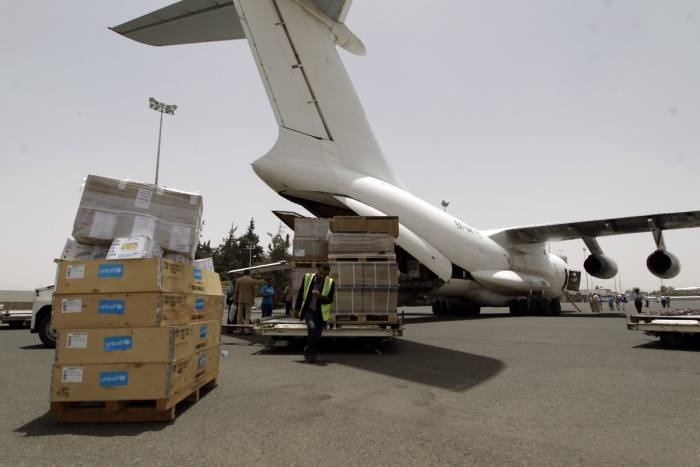What is a ‘humanitarian pause’ and what does it mean for Yemen?
The escalating humanitarian crisis in Yemen has forced more than 300,000 innocent civilians to flee their homes in recent weeks, with violent clashes impacting virtually the entire country. Thousands of civilians are trapped in areas of conflict unable to leave or seek medical help or life-saving assistance. Even the most conservative figures put the death toll at more than 1,500 since March, with the number steadily climbing. Humanitarian organizations have been struggling to safely deliver urgently needed supplies such as food, water and medicine. In light of the deteriorating humanitarian situation and access limitations, a five-day ‘humanitarian pause’ in Yemen began at 11 pm local time on 12 May following days of escalating violence. What exactly does it mean to hold a ‘humanitarian pause’ and will it have an impact?

On 10 April 2015, a first airlift of urgent medical and other supplies from UNICEF is unloaded on the tarmac at Sana’a International Airport.
Limited humanitarian access
The violence in Yemen, including air strikes targeting the runways at the international airport in the capital, Sana’a, has severely constrained efforts to deliver aid. While dozens of humanitarian organizations continue to deliver aid and protect people wherever possible, mainly through national staff and local partners, the threat of violence poses significant constraints, and humanitarian needs outpace the response. Yemen is 90 per cent dependent on imports for its food and fuel — a massive logistical operation on a daily basis. Fuel shortages have put the country’s health system at imminent risk of collapse, have stopped many water pumps from operating, and risk bringing the telecommunications network, as well as the majority of aid operations, to a halt.
“The infrastructure, health, all the other vital services people need, they’re in a state of collapse,” said UN OCHA’s Director of Operations, John Ging. “The ICRC [International Committee of the Red Cross] has been describing the situation as catastrophic and I think that is about the best word to describe the plight of the Yemeni people right now.”
What is a humanitarian pause?
Since March 2015, UN Secretary-General Ban Ki-moon has been calling for a ceasefire, urging all parties to resolve the conflict through a political process. Short of this, the UN chief has called on parties to conflict to hold ‘humanitarian pauses’ in conflict-affected areas.
While an end to fighting is almost always the most positive humanitarian outcome in a conflict, when this is unachievable in the short term, and when conflict severely exacerbates humanitarian conditions, the United Nations, civil society organizations, or political leaders, separately or in unison, may call for a humanitarian pause. According to the UN, a humanitarian pause is defined as “a cessation of hostilities negotiated purely for humanitarian purposes.” This means a short break in the fighting, sometimes in designated areas, with explicit guarantees given by relevant warring parties to humanitarian actors on the ground so that aid can get through to affected-people. A ‘humanitarian pause’ can be a vital pause in hostilities, providing a life-saving respite for civilians.
In Yemen, the pause allows civilians trapped in conflict zones to access assistance, receive medical treatment or to safely get out. It would also enable the safe passage of humanitarian personnel to bring essential supplies, such as medicines, fuel, food, shelter and other essentials, into the country and distributed to communities.
A pause is usually defined for a specific period and for specific geographic areas. However, there is no standardized approach. “Each context is different…It could be one pause or repeated ones,” said Karen Perrin, Policy Adviser at OCHA. It could also involve ‘de-confliction arrangements’ — exchanging logistical information between humanitarian actors and parties to conflict to communicate the time and locations of relief activities to ensure military operations do not endanger humanitarian personnel and beneficiaries, or both.
Whether the pause is 48 hours, 72 hours or longer, it is an intense, high-pressure operation. In Yemen, working against the clock, aid workers will have to remove dead bodies, hurry to bring in fuel and food, and attempt to replenish several hospitals with medical supplies while stocking the most vulnerable areas with food and fuel reserves for the future.
Under International Humanitarian Law, all parties to conflict have the responsibility to allow unimpeded humanitarian access and ensure the safety of humanitarian staff, assets and facilities. Any calls to enable more limited humanitarian assistance, such as a humanitarian pause, do not detract from these responsibilities.
Securing agreement
To succeed, humanitarian partners must be able to make full use of the pause by implementing an operational plan that ensures the necessary infrastructure repairs, including on the airport, to deliver assistance, as well as to bring in fuel and personnel ahead of time so they can quickly carry out operations.
“What is important to remember is that all parties at any time during a conflict have an obligation to protect civilians, and to allow and facilitate rapid and unimpeded humanitarian access to all affected-people,” says Karen Perrin, OCHA Policy Adviser.
Natasha Scripture currently works at the United Nations Office for the Coordination of Humanitarian Affairs in New York, but jumps at any chance to go to the field. For four years, she covered crises around the world for the United Nations World Food Programme (WFP) and UNICEF, including conflicts and natural disasters in countries such as Haiti, Pakistan, Ethiopia, and Libya. When she’s not on the road, she’s writing books, tango dancing, and blogging about dating for the New York Times.
source: UN Office for the Coordination of Humanitarian Affairs
- 476 reads
Human Rights
Ringing FOWPAL’s Peace Bell for the World:Nobel Peace Prize Laureates’ Visions and Actions

Protecting the World’s Cultural Diversity for a Sustainable Future

The Peace Bell Resonates at the 27th Eurasian Economic Summit

Declaration of World Day of the Power of Hope Endorsed by People in 158 Nations

Puppet Show I International Friendship Day 2020

